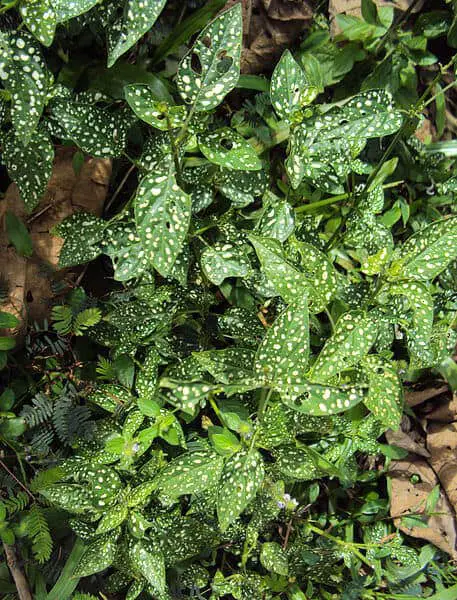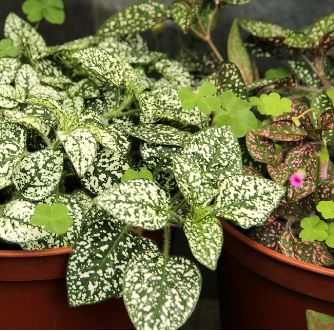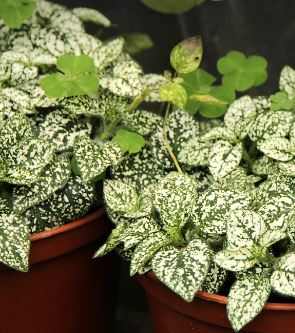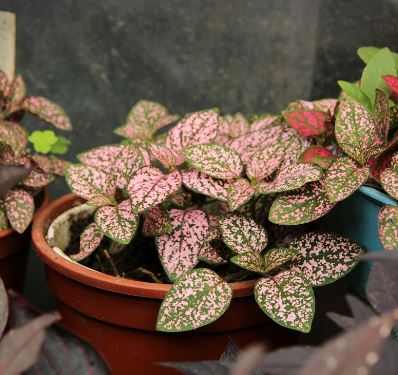Polka dot plants (Hypoestes phyllostachya) add a vibrant touch to indoor and outdoor spaces, but they can sometimes become leggy, affecting their overall appearance and health. In this guide, we’ll explore effective strategies to address legginess, from simple pinching techniques to proper propagation methods.
Polka dot plants become leggy due to factors like low light, nutritional deficiencies, and rapid growth. To address this, regularly pinch back the top leaves, cut back to stimulate new growth, provide adequate light, and snip off inconspicuous flowers. Propagation is also an option for revitalizing leggy plants.
Understanding Legginess in Polka Dot Plants
Why do polka dot plants become leggy? Polka dot plants may become leggy due to factors such as insufficient light, nutritional deficiencies, or rapid growth. Recognizing the signs of legginess is crucial for implementing the right corrective measures.
Polka dot plants are known for their attractive foliage, featuring distinctive spots that add a playful charm to any setting. However, when these plants become leggy, with long stems and sparse leaves, it’s a sign that they may not be receiving optimal care. Legginess often occurs in low-light conditions, leading to stretched-out growth as the plant reaches for available sunlight.
Assessing Your Leggy Polka Dot Plant
How can I identify legginess in my polka dot plant? Leggy polka dot plants exhibit elongated stems, with noticeable gaps between leaves. The lower part of the plant may appear bare, and the overall structure lacks the compactness typical of a healthy specimen.
To assess whether your polka dot plant is leggy, take note of the spacing between leaves along the stems. A bushy and well-maintained plant will have a more dense arrangement of leaves, creating a lush and attractive appearance. Additionally, compare the height of your plant to its overall leafiness; a leggy plant will have disproportionately long stems.
Pinching Back for Bushier Growth
Why is pinching back important for a leggy polka dot plant? Pinching back your leggy polka dot plant is a key technique to encourage bushier growth. This process involves removing the top set of leaves regularly, redirecting the plant’s energy towards lateral bud development.
- Identify the top set of leaves: Locate the uppermost set of leaves on each stem.
- Use clean, sharp scissors or pruning shears: Ensure your tools are clean to prevent the spread of diseases.
- Pinch back regularly: Make pinching back a weekly routine to consistently promote bushier growth.
- Consider alternative pinching methods: Experiment with cutting or pinching the top two leaves on each stem for variation.
By consistently pinching back your polka dot plant, you encourage it to branch out laterally, creating a fuller and more compact appearance.
Cutting Back: Strategies for Optimal Growth
How does cutting back contribute to a healthier polka dot plant? Cutting back your polka dot plant shorter than desired serves as a reset, stimulating new growth and creating a more balanced and aesthetically pleasing structure.
- Determine the cutting point: Choose a point lower than the desired height to allow room for new growth.
- Cut above stem joints: Opt for cutting just above a stem joint to encourage branching and lateral growth.
- Monitor plant response: Observe how your plant responds to the cutting; it should start branching out within weeks.
- Adjust cutting frequency: Tailor your cutting frequency based on the growth rate of your plant.
Cutting back is an effective way to manage the height of your polka dot plant and maintain a more desirable shape. Continued pruning encourages a denser and healthier appearance over time.
Providing Adequate Light for Optimal Growth
How does light availability impact polka dot plant legginess? Insufficient light is a common cause of legginess in polka dot plants. By understanding the light requirements of these plants, you can create an environment that encourages compact and robust growth.
- Assess current light conditions: Determine the amount of natural light your plant receives.
- Increase light exposure: Move your polka dot plant to a brighter location, either indoors near a window or outdoors in partial sunlight.
- Supplement with artificial light: If natural light is limited, consider using grow lights to provide the necessary light spectrum for optimal growth.
Adjusting light conditions is a crucial step in preventing and addressing legginess. Adequate light promotes photosynthesis, leading to healthier and more compact foliage.
Snipping Off Flowers: Focusing on Foliage Growth
Why should I snip off flowers from my polka dot plant? While polka dot plant flowers are charming, removing them redirects the plant’s energy back into foliage production, addressing legginess and enhancing overall plant health.
- Identify inconspicuous flowers: Keep an eye out for small, less noticeable flowers that may appear in summer and fall.
- Use clean pruning tools: Ensure your tools are sanitized to prevent the spread of diseases.
- Snip off flowers: Carefully remove the flowers to divert energy back into the development of leaves.
- Monitor foliage development: Observe how the plant responds, with a focus on increased leaf production.
Removing flowers, especially when they are not the primary attraction of the plant, promotes a more vigorous and balanced growth pattern.
Propagating Polka Dot Plants: Creating New Beginnings
How can propagation help address legginess in polka dot plants? Propagation is a valuable technique to rejuvenate leggy polka dot plants and create new, healthy specimens. By taking stem cuttings and rooting them, you can expand your collection or share these beautiful plants with others.
- Gather necessary materials: Prepare clean pruning shears, a suitable rooting medium, and containers for propagation.
- Select healthy stems: Choose stems with several nodes and a few sets of leaves.
- Cut below a node: Make a clean cut just below a node using sharp pruning shears.
- Remove lower leaves: Strip the lower leaves from the cutting to expose nodes for rooting.
- Root in water: Place the cuttings in a container of water, changing the water regularly until roots develop.
Propagation not only addresses legginess but also allows you to enjoy the satisfaction of nurturing new plants from your existing polka dot specimens.
Indoor vs. Outdoor Cultivation: Tailoring Care to the Environment
Is my polka dot plant better suited for indoor or outdoor cultivation? Understanding the advantages and challenges of both indoor and outdoor environments helps you tailor your care routine to ensure the optimal growth of your polka dot plant.
Indoor cultivation provides control over environmental factors, making it suitable for those who want year-round greenery. However, polka dot plants may benefit from outdoor conditions, such as natural sunlight and airflow.
Indoor Cultivation:
- Select an appropriate container: Choose a well-draining pot with sufficient room for root development.
- Place near a bright window: Position your plant where it receives indirect sunlight for several hours a day.
- Maintain consistent temperature: Keep indoor temperatures within the plant’s preferred range.
Outdoor Cultivation:
- Choose a suitable outdoor location: Select a spot with partial sunlight and well-draining soil.
- Monitor weather conditions: Be aware of temperature fluctuations and protect your plant during extreme weather.
- Allow for natural growth: Outdoor cultivation provides space for the plant to reach its full potential.
Adapting your care routine based on the chosen environment ensures the longevity and vitality of your polka dot plant.
Blooms and Foliage: Exploring Polka Dot Plant Flowers
What should I know about polka dot plant flowers? Understanding the characteristics of polka dot plant flowers and their seasonal patterns enhances your overall care approach, allowing you to appreciate the full beauty of these plants.
Description of Flowers:
- Color and appearance: Polka dot plant flowers come in various colors, complementing the plant’s foliage.
- Blooming periods: Flowers typically appear in summer and fall, adding seasonal interest to the plant.
Balancing Flower and Foliage Care:
- Prioritize foliage health: Since the primary appeal of polka dot plants lies in their leaves, focus on maintaining lush foliage.
- Selective flower removal: Snip off inconspicuous flowers to maintain energy for foliage development.
By understanding the interplay between blooms and foliage, you can create a well-balanced care routine for your polka dot plant.
Where to Cut for Successful Propagation
Where should I cut my polka dot plant for optimal propagation success? Identifying the right cutting points is crucial for successful propagation. Knowing where to cut ensures that your stem cuttings have the best chance of developing strong roots.
- Select nodes for cutting: Nodes are points on the stem where leaves and roots emerge. Choose a cutting that includes at least one or two nodes.
- Use sharp pruning shears: Clean, sharp tools minimize stress on the plant and improve the chances of successful rooting.
- Cut just below a node: Make a clean cut just below a node, ensuring the cutting is of sufficient length for propagation.
- Remove excess foliage: Strip the cutting of excess leaves, leaving only a few sets to reduce stress on the plant.
Creating an optimal cutting and preparing it correctly sets the foundation for successful propagation and the development of healthy roots.
Frequently Asked Questions (FAQs)
How often should I pinch back my polka dot plant?
Regular pinching back is essential for encouraging bushy growth. The frequency depends on factors such as the plant’s age and growth rate. As a general guideline, aim to pinch back the top set of leaves on each stem weekly. This consistent practice promotes lateral bud development, resulting in a fuller and more compact appearance over time.
Can I propagate my polka dot plant in soil instead of water?
Yes, you can propagate your polka dot plant in soil as an alternative to water propagation. Follow these steps for successful soil propagation:
- Prepare a well-draining soil mix: Use a combination of potting soil and perlite or sand for optimal drainage.
- Insert cuttings into soil: Plant the cuttings in the prepared soil, ensuring nodes are covered and the cutting is secure.
- Maintain consistent moisture: Keep the soil consistently moist but not waterlogged to support root development.
- Monitor growth: Observe the cuttings for signs of rooting and new growth.
Soil propagation provides an alternative method for expanding your polka dot plant collection.
What is the best time to cut back a leggy polka dot plant?
The timing of cutting back a leggy polka dot plant depends on the plant’s growth cycle and environmental conditions. Ideally, perform the cutting back during the growing season, which is typically spring or early summer. This allows the plant to redirect energy into new growth, taking advantage of the favorable conditions for recovery.
Should I remove all flowers for better foliage growth?
While polka dot plant flowers are charming, removing all of them may not be necessary. Instead, focus on snipping off inconspicuous flowers that divert energy away from foliage development. By selectively removing flowers, you strike a balance between enjoying blooms and maintaining robust foliage.
Is my polka dot plant suitable for both indoor and outdoor settings?
Polka dot plants are adaptable to both indoor and outdoor environments, offering flexibility for plant enthusiasts. When grown indoors, choose a well-lit location near a window, ensuring the plant receives indirect sunlight. For outdoor cultivation, select a spot with partial sunlight and well-draining soil. Transitioning between indoor and outdoor settings is possible, allowing you to cater to the plant’s needs and your preferences.
How do I know if my polka dot plant is receiving enough light?
Insufficient light is a common cause of legginess in polka dot plants. Signs that your plant may not be receiving enough light include elongated stems, sparse foliage, and a generally stretched-out appearance. To address this issue, assess the current light conditions and consider moving the plant to a brighter location. If natural light is limited, supplement with artificial grow lights to provide the necessary light spectrum for optimal growth.
Can I use fertilizer to address legginess?
While fertilizer is beneficial for overall plant health, it may not directly address legginess caused by factors like low light. However, providing the plant with a balanced fertilizer during the growing season can support overall vitality. Choose a fertilizer with equal parts nitrogen, phosphorus, and potassium, and follow the recommended application rates. Remember that correcting the underlying causes of legginess, such as adjusting light conditions, is essential for effective long-term management.
What are the signs of overwatering or underwatering a polka dot plant?
Overwatering and underwatering can both negatively impact polka dot plants. Signs of overwatering include yellowing leaves, wilting, and root rot. On the other hand, underwatering may lead to drooping leaves, dry soil, and overall poor plant health. Maintain a balanced watering routine by allowing the top inch of soil to dry out before watering again. Adjust your watering frequency based on environmental conditions and the plant’s specific needs.
How long does it take for a propagated cutting to root?
The time it takes for a propagated cutting to root can vary based on factors such as environmental conditions, the plant’s health, and the propagation method. Generally, it takes a few weeks for roots to develop when propagating polka dot plants in water. Ensure that the cutting remains in a well-lit location and change the water regularly. Monitor the cutting for the emergence of roots, and once they are well-established, the cutting can be potted in soil for continued growth.
Are there specific pests that affect polka dot plants?
Polka dot plants are susceptible to common indoor plant pests, including spider mites, aphids, and whiteflies. Regularly inspect your plant for signs of pest infestation, such as discolored or distorted leaves. Use natural remedies like neem oil or insecticidal soap to control pests, ensuring thorough coverage of both upper and lower leaf surfaces. Additionally, practice good plant hygiene by removing fallen leaves and debris to prevent pest habitats.
Conclusion
In conclusion, reviving and enhancing your leggy polka dot plant involves a combination of proactive measures, from pinching back and cutting to providing optimal light conditions and addressing flowering. Understanding the unique characteristics of polka dot plants and tailoring your care routine to their needs ensures a thriving and visually appealing addition to your indoor or outdoor space. By following the guidelines presented in this comprehensive guide, you’ll be well-equipped to overcome legginess and foster the continued health and beauty of your polka dot plants.





I am using All purpose Plant food by Miracle Gro. you can try that.
Polka Dot Plant Outdoors – Tips to Grow Hypoestes phyllostachya
Polka Dot Plant Toxic to Cats – Is Hypoestes Safe for Pets?
How to Prune Polka dot Plant – Trimming Hypoestes Guide(WITH CARE)
Pink Polka Dot Plant – Information and Caring Guide(With Best Soil)
Polka Dot Plant Leaves Curling?
